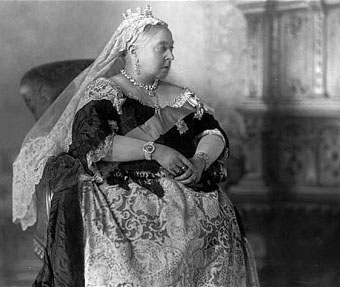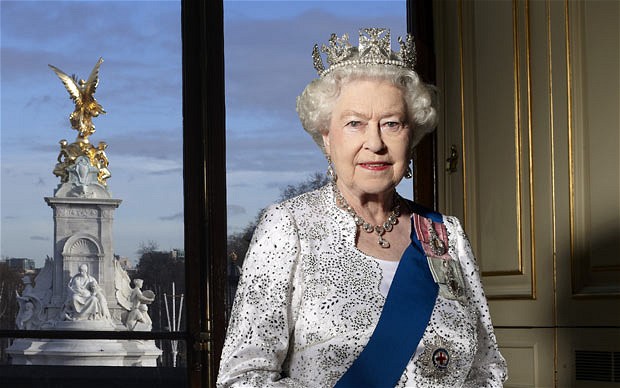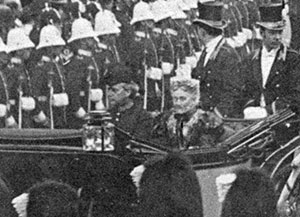The Queen's Diamond Jubilee!

It's true. We're talking 1897 and the Diamond Jubilee of Alexandrina Victoria Hanover – or Queen Victoria, the "grandmother of Europe" and the last of the royal line of Hanovers. (Not to mention the great great grandmother of Elizabeth II, our own 60-year reigning monarch and celebrant.)
Royal bloodlines create a small gene pool of potential paramours within the blue bloods of Europe and thus, Victoria was actually almost entirely of German descent. She was the granddaughter of George III (Hanover), the daughter of Prince Edward Augustus (Hanover) and the daughter of Princess Victoria of Saxe-Coburg-Saalfeld. And she married into another German line when she tied the knot with Prince Albert of Saxe-Coburg and Gotha.
The spectacle of Victoria's jubilee processional ('parade' for the layman) might have displayed cultures, colours, and peoples from around the world (Canada, India, Australia, New Zealand, South Africa, etc.), but Victoria didn't just preside over one of the largest Empires in the history of the world... Victoria also presided diligently over her bloodline. She was said to have arranged the marriages of her nine children, and her 42 grandchildren, to other blue bloods across the continent, tying Europe together — royally at least — and earning her the nickname the grandmother of Europe.
 So how did our current monarch – our very own Queen Elizabeth II (of Windsor), Victoria’s great great granddaughter – end up with such a British sounding surname? Look no further than the Great War 1914-1918. When World War I broke out, Victoria’s grandson, George V (of Saxe-Coburg and Gotha), was the King of the United Kingdom and its dominions (including Canada). But George’s first cousin – and another Victoria grandson – was Kaiser Wilhelm II, Emperor of Germany and King of Prussia — the enemy.
So how did our current monarch – our very own Queen Elizabeth II (of Windsor), Victoria’s great great granddaughter – end up with such a British sounding surname? Look no further than the Great War 1914-1918. When World War I broke out, Victoria’s grandson, George V (of Saxe-Coburg and Gotha), was the King of the United Kingdom and its dominions (including Canada). But George’s first cousin – and another Victoria grandson – was Kaiser Wilhelm II, Emperor of Germany and King of Prussia — the enemy.
With a British populace at war against Germany, and the inherent anti-German sentiment thoughout the British Empire (witness Berlin, Ontario's name change to Kitchener, Ontario in 1916), George decided to prove his loyalty to his British and Dominion subjects. So in July 1917, with the Great War still in full swing, wreaking devastation across the battlefields in France and Belgium, King George V officially decreed that "all descendents in the male line of Queen Victoria, who are subjects of these realms, other than female descendents who marry or who have married, shall bear the name Windsor."
The new royal surname Windsor was borrowed from the royal castle of the same name. And thus, the "House of Saxe-Coburg and Gotha" became the very British-sounding "House of Windsor." And thus, it is Elizabeth Windsor who is now presiding over her own 60th anniversary Diamond Jubilee, as Queen of the United Kingdom and Commonwealth realms.
*****
1897 – Wilfrid & Mrs Laurier at Queen Victoria's Jubilee
| Powered by Zoomify |
What do you see?
Use the Zoomify controls to get a closer look.
The main Jubilee celebrations, including this extravagant Diamond Jubilee Procession in London, England, took place on 22nd June 1897. In this photo, newly knighted Sir Wilfrid Laurier, Prime Minister of Canada, sits in carriage with his wife Lady Zoé Laurier. They have just travelled through the archway of the Wellington Arch, the large monument in the background, which sits at the entrance to Green Park. (At the time of this photo, the monument is without its statue of the Duke of Wellington on horseback atop, having been removed.)
 Laurier's carriage has just travelled 500m from Buckingham Palace, west on Constitution Hill, through the Wellington Arch, and has now turned right onto a street that no longer has the same configuration since the arch now sits in the middle of a traffic island. (See current View on Google Maps - opens in new page.)
Laurier's carriage has just travelled 500m from Buckingham Palace, west on Constitution Hill, through the Wellington Arch, and has now turned right onto a street that no longer has the same configuration since the arch now sits in the middle of a traffic island. (See current View on Google Maps - opens in new page.)
While he was in London, Laurier was knighted on 21st June 1897, mostly against his wishes. He had not wanted a knighthood, but the process was already well under way by the time he arrived in England, and in order to avoid being rude, Laurier acquiesced. The next day, 22nd June, Laurier's was the first carriage in the procession that closed with the Queen's carriage. (See Detail of Wilf & Zoé at right, or magnify the photo with Zoomify above to get a closer look.)
Do you see anything else interesting? Let us know. Please Contact Us. (Photo: Library and Archives Canada c028730)
*****
Just like Elizabeth's 2012 festivities, Victoria's Diamond Jubilee commemorations in 1897 took place over several days as well. Check out this description of the 1897 celebrations from:
A Celebration of Empire: Queen Victoria's Diamond Jubilee
by Diane Peters, 1998, Wilfrid Laurier University Library
"As they had in 1887 (for the Golden Jubilee, ed.), the Jubilee celebrations in Britain began on Accession Day, Sunday, June 20, when the Queen took part in a simple ceremony of thanksgiving at St. George's Chapel in Windsor. It featured the Jubilee Hymn 'O King of Kings', with text by the late Bishop of Wakefield and music by Sir Arthur Sullivan, which had been appointed for use in all churches and chapels throughout the Empire on that day. The service also included a rendition of the 'Hymn of Praise', by Mendelssohn, one of the Queen's favourite composers, which was sung by Canadian soprano Emma Albani.
"The following day, June 21st, was a significant day for Canada. In the morning, it was officially announced that the honour of 'Knight Grand Cross in the Most Distinguished Order of St. Michael and St. George' would be bestowed upon the Canadian premier, as the representative figure among the colonial leaders. Wilfrid Laurier became Sir Wilfrid in a ceremony at Buckingham Palace that evening.
"The main Jubilee celebrations took place on June 22nd. The Canadian cavalry opened the Colonial Procession, riding five abreast. The Right Hon. Sir Wilfrid Laurier came next, occupying the first of the carriages. (See photo above.) Directly behind him was a detachment of the Toronto Grenadiers and Royal Canadian Highlanders. Following them were troops representing the breadth, and the colour, of the entire Empire. Next came the Royal Procession, which included an assortment of alternating military bands and squadrons, sheriffs on horseback, a hundred equerries, gentlemen-in-waiting and military attaches, and carriages carrying sundry English and foreign princes, and other royals. Finally, a carriage appeared drawn by eight cream-coloured horses and bearing the Queen herself."
Read more about Queen Victoria, and why we still celebrate her birthday May 24 weekend — the opening of Canadian summer! ![]()
*****
If you have any observations, comments, insights, or see any errata, or anything nutty when viewing these photos, please Contact Us.





